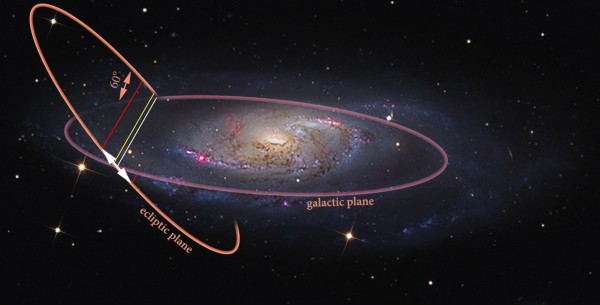“There is no such thing as perpetual tranquillity of mind while we live here; because life itself is but motion, and can never be without desire, nor without fear, no more than without sense.” -Thomas Hobbes
Well, it finally happened: someone asked me about the accuracy (or inaccuracy) of a certain viral video.
 Image credit: National Astronomical Observatory ROZHEN, via http://sob.nao-rozhen.org/content/doomsday-21-december-2012-end-world-o….
Image credit: National Astronomical Observatory ROZHEN, via http://sob.nao-rozhen.org/content/doomsday-21-december-2012-end-world-o….

The movement through space is one of the things that has always bugged me about time travel. Assume that you could go forward or backward in time. Unless you could also calculate precisely where the earth would be in space you’d end up in interstellar space.
And if you do manage to figure that out, you would have moved huge distances in a very short time. So you’d violate the rule against traveling faster than the speed of light as well.
One way around that would be if space drags its time reference around with it, but I don’t think that happens.
@ Ethan,
Re your comment on the fifth illustration:
Consider how dishonest so many features of this image are. First off, the planets, at any given point in time, all are actually in the same plane. There is no lag at all, with outer planets farther “behind” the Sun than the inner ones in any sense.
Before I read you comment I interpreted the picture as illustrating the angle and obliquity of the solar system’s ecliptic plane relative to the point of view (POV), presumably from the direction of the galactic centre. There was also an attempt to portray perspective with planetary sizes when the planets come closer to the POV and go further away.
I did not interpret this illustration as an attempt to portray any “lag” or showing the outer planets as being “behind” the sun.
Ethan, this is a great clarification to the slightly imprecise aspects of the great video by DJ Sandhu; ha has stated the video is only to depict motion and not time.
Can you throw light on why everything spins and how a point on earth - the peak of everest - appears to move from Andremeda due to the combined effect of its own spin, revolution around sun, solar system movement around galactic centre and the rotation of Milkeyway?
Could you carry this subject a little further and show our relative poles (ecliptic plane) with respect to the galactic plane? This may help clarify why it is we can view the galactic centre, and the outer reaches at different times during our yearly solar cycle.
If the orbiting planets left a trail emanating from the ecliptic as the animation depicts, does that not imply the plane is either travelling toward, or away from the galactic centre? Would it be more prudent to show the orbits in the plane moving along with the rim of the ecliptic leading as it orbits our galaxy ?
if the planets in the solar system have a seemingly helical trajectory, during their formation, wouldn't the suns galactic trajectory determine the planetary orientation?